|
Riesling Wine
So why the misunderstanding? Well, many people assume that all Riesling is sweet. Not so. They also assume that sweet Riesling is bad, that it is syrupy and cloying. Also not so. Part of these problems come from the fact that the very best examples of Riesling wine come from Alsace in France, Germany and Austria, three wine growing regions that the casual drinker often knows nothing about and may be intimidated by venturing into. The wines and their names can oftentimes be quite confusing. JJ Prum Wehlener Sonnenuhr Spätlese anyone? The names and labels are often daunting to say the least. So most novice wine drinkers simply ignore these wines and regions. The only Rieslings they may have tried are those made in California. However, Riesling is a grape that really excels in cooler climates, taking the long growing season to slowly ripen while retaining vibrant acid. In warmer weather, the grapes get sweet and loose acid. Many of these examples are indeed quite sweet and do not have the acid to balance the sweetness. They taste flabby and cloying, lacking any grip and balance. The Riesling grape variety is very affected by the soil in which it grows and therefore only reaches its greatest heights in certain places, most notably the best vineyards of Alsace, Germany and Austria. Where Is Riesling Wine Made?Arguably the most classic examples of Riesling are grown in France, Germany and Austria. In France, the northeastern region of Alsace borders Germany and if you visit it looks like Germany too. Indeed, through history the border has gone back and forth.In Germany, many regions produce outstanding Riesling. Some of the most famous include the Mosel-Saar-Ruwer river valley, the Nahe and the Reingau. In Austria, there are also many regions that produce excellent Riesling What Styles of Wine Does Riesling Produce and What Do They Taste Like?Like Chenin Blanc, Riesling is capable of both great ripeness and high acid. For this reason, it is capable of producing quite a wide variety of wine styles, from bone dry to super sweet. Also, because it is very influenced by the soil in which it grows, its specific characteristics can vary considerably from one vineyard to the next.Dry Riesling is often quite intense, full of mineral influence and high acid, the wines are taut and penetrating. Sweeter Rieslings can vary tremendously from just off-dry to sticky sweet. Often people assume that they will not like wines with some sweetness to them, for the reasons discussed above. However, a good German or Austrian Riesling with some residual sugar has high acid and minerality to it which amply balances the sweetness of the sugar. Therefore, these wines taste in balance and are still vibrant, fresh and refreshing, not sticky, cloying and flabby. That being said, these Rieslings do vary quite a bit. While German Kabinett and Spätlese (see the nomenclature below) are just off dry and are delicious with a wide range of foods, the Beerenauslese and Trockenbeerenauslese are very sweet and really dessert wines in nature. In general, Riesling wine is a very age-worthy, improving in bottle in a cool cellar for years, decades or even centuries. Riesling NomenclatureBecause Riesling styles vary so much there is a great deal of nomenclature that is used to describe the different ripeness and sweetness levels of the wines. These vary from region to region and can get quite confusing. Here are some of the basic nomenclature used for many Riesling wines.In Alsace, most basic Riesling wine is dry. The wines have little or no residual sugar. Some wines are designated as Vendage Tardive, which means late harvest. These wines are made from riper grapes and are generally sweet. However, they are no sticky sweet dessert wines. The highest level of ripeness is called Selection de Grains Nobles and is made exclusively from grapes affected by botrytis. These are thick, rich, very sweet wines. In Germany, the nomenclature of Riesling wine is even more complicated. There are several different types of designations and levels of wine produced. Many of the best wines produced in the traditional manner from the best vineyards follow a heirarchtypal grading system that is based on the level of ripeness of the grapes when they are harvested, as follows: Kabinett: The least ripe level of German Riesling, Kabinett wines are generally just off-dry. They are generally lighter in body but have a great intensity and crisp minerality. Spälese: Slightly riper, with more residual sugar. These are still just off-dry but have some noticeable sweetness. Auslese: While these come from late harvested, ripe grapes, the sweetness is well balanced by acid and mineral flavors. While they can be quite sweet, they are generally balanced enough to pair well with food, particularly spicy cuisine such as Thai food. These can vary somewhat and some producers label different bottlings of Auslese differently, separating them by fuder (barrel) number or other more confusing designations (two stars, three stars, gold capsule, long gold capsule, etc.). The different bottlings can be quite different from each other, both in terms of sweetness and in other characteristics of the wine. Beerenauslese: Very late harvested and quite sweet, these are generally considered dessert wines. The grapes are often affected by botrytis, although not only these grapes are used. Trockenbeerenauslese: The ripest and highest sugar content grapes go into this level of wine. It is exclusively produced from hand-picked botrytis affected grapes, a painstaking process. These wines are very rich and sweet. They also tend to be very expensive, often costing hundreds of dollars for a small 375ml bottle. Other Designations: Some dry wines are labeled Trocken. Just off-dry wines can be labeled Halbtrocken (half dry) or Feinherb. Sweet dessert wines produced from late harvested grapes that have been allowed to freeze on the vine are called Eiswein (ice wine). I told you it was complicated! Return to the Grape Varieties section.  |



 Riesling wine is often misunderstood by the casual wine drinker. I would say emphatically that Riesling is one of the greatest white grapes in the world, perhaps the greatest. It is capable of thrilling heights. Wines that make you say "wow". Yet it is capable of great finesse, refinement, and subtlety.
Riesling wine is often misunderstood by the casual wine drinker. I would say emphatically that Riesling is one of the greatest white grapes in the world, perhaps the greatest. It is capable of thrilling heights. Wines that make you say "wow". Yet it is capable of great finesse, refinement, and subtlety.


